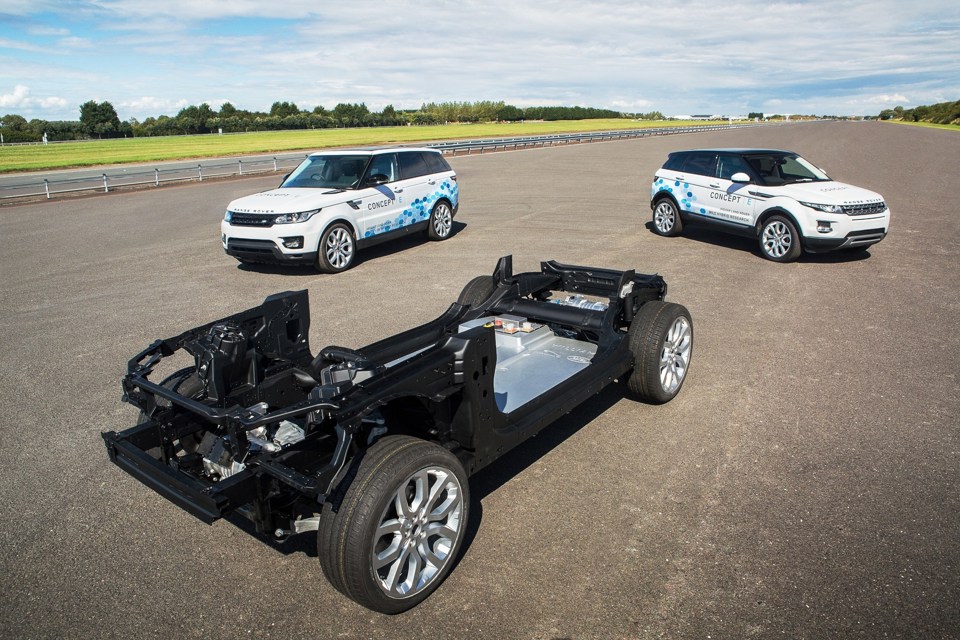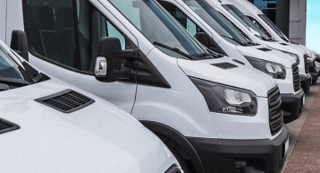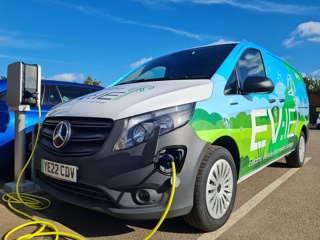Green car technology is gathering pace. From dramatic improvements in electric vehicle (EV) technology, through investigations into car aerodynamics and heating/cooling systems, to research into alternative fuels, manufacturers are putting great effort into innovative solutions that will bring much lower emission rates. Here, we provide an overview of the main developments.
Electrification
The electrification of vehicles was one of the themes running through the recent Frankfurt motor show, with the majority of manufacturers showing how they aim to use electricity to power their vehicles – whether it is a fully-electric, mild hybrid or plug-in hybrid powertrain.
Nissan has been one of the pioneers of EVs through its fully-electric Leaf and at the motor show it launched a new model which offers a range of 155 miles – 26% more than the existing car.
It has achieved the extra range by introducing a 30kWh battery, which is the same size as the existing 24kWh unit but is 21kg heavier at 239kg.
Key to the new battery’s distance gains is an update to its internal design and chemistry. The introduction of a high capacity cathode improves performance, while the change to the cell layout also contributes.
A number of manufacturers have also unveiled cars with electrified powertrains and James Wright, managing director of Nissan Motor (GB), says this will increase the uptake of the technology.
“For a long time we were the only manufacturer with an EV in the market, so we were trying to convince everybody about the new technology but with a fairly limited budget,” he says.
“There are now more competitors being launched and this will be good for us: it will help stimulate the market.
“At the start we were alone. We were facing a sceptical media focusing on the downsides and none of the upsides of EVs. Over the past couple of years we’ve seen this change and this change is starting to accelerate because more companies are spending their marketing budgets to promote the technology.
“They are bringing their different classes of the technology to market, whether it be in sports cars or SUVs, and this will change customer perceptions.”
Another pioneer in EVs – this time through hybrid technology – is Toyota, which unveiled its fourth-generation Prius hybrid at Frankfurt.
The manufacturer says the new model has been given the target of reducing CO2 emissions by 18% compared with its predecessor, with fuel efficiency improving to around 90mpg.
Its new hybrid system will come in a more compact package, lighter in weight and lower in cost, says the manufacturer. The 1.8-litre petrol engine is set to remain with
a downsized electric motor and a separate electric power unit to drive the rear wheels. This ‘e-4WD’ system will only work at speeds of up to 37mph but will boost grip in poor weather conditions.
“Like previous generations, this new Prius introduces an entirely new drivetrain that will find its way into a growing number of new Toyota models,” says Karl Schlicht, executive vice-president of Toyota Motor Europe.
Many other companies also unveiled their variations of electric power at Frankfurt.
Citroën, for example, featured a plug-in hybrid powertrain on its Aircross concept. With a combined power output of 313hp, the manufacturer claims CO2 emissions of 39g/km, fuel economy of 166mpg and a 31-mile range on electric power alone.
Renault also announced that its new Mégane will, from 2017, be available with a mild hybrid system which will provide combined fuel economy of 94.1mpg and CO2 emissions of 76g/km, subject to confirmation.
Premium manufacturers are also investing significant sums into the technology.
Jaguar Land Rover is developing a high-performance, electric drive module (eDM), which it says is capable of producing twice the power and torque of any electric motor-generator in production today.
These can be inserted between any engine and transmission to create a mild hybrid or plug-in hybrid, or used alone for a full EV.
“This is a long-term Jaguar Land Rover research project exploring all aspects of future hybrid and battery electric vehicle technology,” says Wolfgang Epple, director of research and technology for Jaguar Land Rover.
“Our three Concept_e vehicles will allow us to test and develop exciting new potential technologies that could form part of our low and zero emissions vision beyond 2020.”
The Concept_e vehicles are:
> Concept_e MHEV. The mild hybrid is based on a Range Rover Evoque donor vehicle and features a prototype 90hp diesel engine and a 48-volt electrical system.
> Concept_e PHEV. The plug-in hybrid employs a similar architecture to the MHEV but with a 300hp prototype petrol engine and eight-speed transmission within a Range Rover Sport donor vehicle.
> Concept_e BEV is a fully-electric research demonstrator based on Jaguar Land Rover’s aluminium vehicle architecture. The chassis features a 70kWh lithium-ion battery and electric axle drive units.
Key to the development of electric technology are tier one suppliers such as Bosch.
It has unveiled a new battery technology for electric cars that it says could be production-ready within five years.
In August, the company acquired US electric car battery developer Seeo Inc, which has been developing solid-state cells for lithium batteries.
“Solid-state cells could be a breakthrough technology,” says Volkmar Denner, chairman of the board of management of Robert Bosch.
Traditional battery packs use electrochemical energy storage and become less safe or reliable the more powerful they are, adds Denner.
The batteries Bosch is developing are based on non-reactive solid polymer electrolytes which are less prone to the flaws that beset current-generation lithium-ion batteries, meaning they can provide an energy density around double that of today’s batteries.
Up to now, the declared industry target has been to double batteries’ energy density and halve their costs by the end of the decade.
However, with the new solid-state cells, Bosch sees the potential to more than double energy density by 2020 and further reduce costs considerably. This increase in energy density will also double the potential range of vehicles.
Aerodynamics
Aerodynamic improvements have been used for many years to help lower vehicle CO2 emissions: the smoother the airflow over a vehicle, the less effort is needed to propel it forward.
‘Eco’ models such as Volkswagen’s Bluemotion range tend to feature devices such as aerodynamic wheels and grilles to lower drag, but Mercedes-Benz has demonstrated what could be possible with its Concept IAA (Intelligent Aerodynamic Automobile).
Unveiled at the Frankfurt motor show, the concept has aerodynamic features – activated at the press of a button or automatically at 50mph – which improve the car’s drag co-efficient from Cd 0.25 to Cd 0.19.
To put that in perspective, when the Mercedes-Benz CLA was launched in 2013 it was the world’s most aerodynamic production car with a drag co-efficient of Cd 0.22.
The Concept IAA’s on-the-move improvement is brought about by a range of measures.
These include: an eight segment extension at the rear of the bodywork, increasing the car’s length by up to 30cm, while flaps in the front bumper extend by 25mm to the front and 20mm to the rear, improving airflow around the front end and the front wheel arches.
The wheels also contribute to the reduction in drag. Featuring a deep 55mm dish at lower speeds and a gap around the perimeter to channel cooling air into the brakes, centrifugal forces gradually cause the dish to become entirely flat by 50mph.
While the aerodynamic measures reduce CO2 emissions by only 3g/km on the EU cycle, Mercedes-Benz engineers claim a 20g/km reduction at 90mph.
“Concept IAA applies intelligent innovations to resolve the conflicting aims of functionality and aesthetics. It also demonstrates that we still have plenty of ideas on how to achieve further improvements in efficiency," says Thomas Weber, member of the Daimler board of management responsible for group research and head of Mercedes-Benz cars development.
Fuel
Ford is leading a £2.5 million research programme investigating the use of alternative fuels which offer the power and performance of modern engines with environmental benefits comparable to an EV.
The German government is co-funding the three-year project that will test the first-ever cars to run on dimethyl ether (DME), commonly used as a non-toxic propellant in aerosol spray gas, and oxymethylene (OflME1), a liquid used as a solvent in the chemical industry.
Both ethers, which will power cars based on the Ford Mondeo, offer the potential for extremely low particulate emissions and enhanced fuel efficiency.
They can be generated from fossil natural gas or bio-gas, or go through a sophisticated process called power-to-liquid that uses renewable sources such as solar or wind power together with CO2 in the air.
“The CO2 produced by a car powered by DME from renewable sources could be comparable to the amount generated by a marathon runner covering the same distance, but with performance similar to a diesel-powered vehicle,” says Werner Willems, technical specialist, powertrain combustion systems, Ford of Europe.
“This is a project that could help place vehicles with significantly reduced CO2 and particulate emissions on the market at affordable costs.”
Audi, in association with energy technology Sunfire, has this year manufactured a synthetic diesel fuel which can be created using only water and CO2 as raw materials.
The car manufacturer says that the resulting fuel, which it calls ‘e-diesel’, is a high-quality diesel free from sulphur and aromatic hydrocarbons, which can be mixed with traditional fossil fuels in order to extend the life of the world’s supply, or potentially even replace it altogether.
“In developing Audi e-diesel we are promoting a fuel based on CO2 that will allow long-distance mobility with virtually no impact on the climate,” says Reiner Mangold, head of sustainable product development at Audi.
Weight saving
Weight saving is crucial to improve fuel consumption and emissions, according to Epple.
“Our engineers lead the world in the development of lightweight vehicle bodies to reduce weight to improve handling, fuel efficiency and emissions," Epple says.
“Our researchers are moving beyond lightweight body structures and are looking at every component in the car, from how to replace traditional wiring looms with printed electronics, to developing prototype seats much lighter than those in today's vehicles.
“We are also investigating how we could make use of carbon fibre in future vehicles by mixing it with innovative new materials like flax, as well as new techniques for manufacturing carbon fibre components in higher volumes than is feasible today.”
Jaguar Land Rover’s research team is investigating whether a vehicle’s copper-based wiring loom and electrical components could be replaced with wafer-thin printed electronic circuits, currently used in curved televisions.
The technology could be deployed as a lightweight and space-saving alternative to traditional wiring for features including instruments, switches, sensing, lighting, heating and displays.
The manufacturer’s research engineers have developed a new type of lightweight polymer seat structure that weighs 30% less than an equivalent steel-based seat structure.
The Places seat technology makes the structural components work as part of the comfort system and enables consolidation of parts, reducing weight. Seat cushions and fabric covering are also optimised for weight without impinging on comfort.
Jaguar Land Rover’s Carbio project looks at how the company could make carbon fibre more environmentally friendly and cost effective, while improving its noise, vibration and harshness (NVH) properties.
The material combines layers of carbon fibre and flax with an environmentally-friendly cashew nut oil resin. Flax is a natural and sustainable plant material and was chosen because of its inherent sound dampening properties.
While the manufacturing cost of Carbio is similar to that of traditional carbon fibre, the material cost of mixing carbon fibre and flax is one-third cheaper. Components made from Carbio are 28% lighter than aluminium and 55% lighter than steel and because of the improved NVH properties provided by the flax, a Carbio component requires less additional sound-deadening material around it than traditional carbon fibre, aluminium or steel, potentially saving even more weight.
Weight saving is also an area of focus for mainstream car manufacturers when developing new models. The new Vauxhall Astra, for example, is up to 200kg lighter than its predecessor depending on the model and trim level.
Every component was checked for compact design and lightweight materials.
The body shell weight alone was reduced by 20% from 357kg to 280kg. Additional, chassis-related measures resulted in a further 50kg weight loss. These include high-strength and ultra-high-strength low-weight steels, compact subframes as well as weight reductions to the front and rear axle.
Air bubble that reduces heating and cooling demands on a car
Jaguar Land Rover is researching how the substantial amounts of energy consumed by heating, ventilation and air conditioning (HVAC) systems can be reduced.
“Today’s HVAC systems can draw 8-10kW from an EV battery, enough to reduce the range by up to 40%, while air conditioning can reduce the range of an internal combustion engine by up to 20%,” says Wolfgang Epple, director of research and technology for Jaguar Land Rover.
“So, to improve the fuel economy and emissions of internal combustion engines and to enhance the range of future EVs, we have been rethinking the thermal management of the vehicle cabin.
“We are developing new methods of heating and cooling the cabin to achieve substantial reductions in energy consumption.”
Rather than continuously heating or cooling a flow of air as it enters the car, Jaguar Land Rover is researching how a car could heat or cool an ‘air bubble’ inside the vehicle once and then maintain the temperature and quality of this air bubble using new technologies.
These include infra-red reflective glass which would reflect the sun’s rays, so less energy is required to cool the inside of the car.
To maintain the breathable quality of the bubble of air, cabin air would be passed through a special filter in the vehicle’s boot. This filter would remove CO2, moisture and particulates from the cabin air and theoretically provide better air quality inside the vehicle than out.






















Login to comment
Comments
No comments have been made yet.